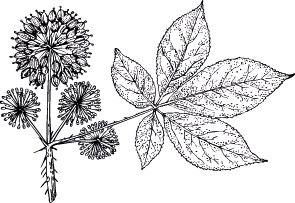ג'ינסנג סיבירי הוא שיח קוצני; מוצאו בצפון ומזרח רוסיה, צפון סין, קוריאה ויפן.
ג'ינסנג סיבירי מותר לשיווק בישראל.
חלק הצמח בשימוש
שורש.
איכויות
טמפרטורה: חמים.
לחות: יבש.
טעם: מתקתק, מריר.
רכיבים פעילים עיקריים
ליגנאנים ופניל פרופאנואידים (eleutherosides A-M, senticosides A-F), פוליסכרידים (כוללים גליקנים, eleutherans A-G), סטרולים, סאפונינים, חומצות שומן.
התוויות
סטרס, סוכרת, דיכאון, הפרעות זיכרון, הפרעות קשב וריכוז, חולשה חיסונית, דלקת מפרקים שגרונית (RA), תסמונת התשישות הכרונית.
מינונים
תמצית נוזלית בריכוז 1:3, 45% אלכוהול – 3-12 מ"ל ביום.
תמצית יבשה תקנית בריכוז 9% eleutherosides – מינון של 400-1000 מ"ג ביום.
מרתח – 1-6 גרם ביום.
בפורמולה – 20%-30%.
רגישות
לא ידועה רגישות מיוחדת.
תופעות לוואי
ג'ינסנג סיבירי עלול לגרום (בשכיחות נמוכה) ל למידע השלם למנויים
מינון יתר
לא ידוע על מינון יתר.
אזהרות וצעדי מנע
משך הנטילה – למטרות מניעה או חיזוק כללי, מומלצת למידע השלם למנויים
התוויות נגד
מסורתית, נהוג להימנע משימוש בג'ינסנג סיבירי בזמן למידע השלם למנויים
ג'ינסנג סיבירי אסור לשימוש באנשים הסובלים מ למידע השלם למנויים
רעילות
לא נצפתה אף תופעת רעילות ולא הושרה מוות בעכברים שהואכלו בשורש ג'ינסנג סיבירי כל מהלך חייהם (במינונים גבוהים פי כמה מהמינון המומלץ לבני אדם)(18), כמו גם בחולדות שהואכלו ב- למידע השלם למנויים
מדד רעילותLD50: למידע השלם למנויים
תגובות הדדיות עם תרופות / צמחי מרפא / תוספי תזונה
חילוף חומרים תרופתי
במספר מחקרים בתנאי מעבדה ובדמם של נבדקים בריאים, לתמציות ו/או למרכיבי ג'ינסנג סיבירי לא נמצאה(21,22) השפעה על מערכת אנזימי ציטוכרוֹם P450.
קיים מחקר בודד(23), שבו הרכיבים eleutheroside B ו-eleutheroside E הדגימו עיכוב קל של אנזימי CYP2C9 ו-CYP2E1. לפי מחקר זה, תיאורטית, עלול לעלות הריכוז בדם של תרופות העוברות חילוף חומרים דרך אנזימים אלו.
בתנאי מעבדה(52), מיצוי של ג'ינסנג עיכב את פעילות המשאבה החלבונית P-gp (גליקופרוטאין P) בתאי סרטן מעי אנושיים. עיכוב המשאבה עשוי תיאורטית להעלות ריכוזן של תרופות ולהפחית עמידות לתרופות. לא נערכו מחקרים קליניים בנושא ולא ברורה הרלוונטיות הקלינית של ממצאים אלו.
Digoxin וגליקוזִידים קרדיאלִיים (תרופות להסדרת קצב הלב) - למידע השלם למנויים
תרופות להורדת סוכר (כולל אינסולין) - למידע השלם למנויים
תרופות נוגדות קרישה - למידע השלם למנויים
כימותרפיה כללי - למידע השלם למנויים
כימותרפיה אנטינאופלסטית (כולל 6-Mercaptopurine ו-Cyclophosphamide) - למידע השלם למנויים
אנטיביוטיקה אמינוגליקוזידית - למידע השלם למנויים
הריון
ג'ינסנג סיבירי מתאים לשימוש בהריון(3,6). במחקרי האכלה שנערכו בבעלי חיים שונים, למידע השלם למנויים
הנקה
ג'ינסנג סיבירי מתאים לשימוש בהנקה(3,6).
מקורות
- Mikunis RI et al. The effect of Eleutherococcus on some biochemical parameters of the blood in the combined treatment of patients with rheumatic lesions of the heart. Lekarstvennye Sredstva Dal’nego Vostoka, 1966, 7:227–230.
- Farnsworth NR et al. Siberian ginseng (Eleutherococcus senticosus): current status as an adaptogen. In: Wagner H, Hikino H, Farnsworth NR, eds. Economic and medicinal plant research. Vol. 1. London, Academic Press, 1985:217–284.
- Mills & Bone - Principles and practice of Phytotherapy. Modern Herbal Medicine, 2ed. Churchill Livingstone, 2013
- Cicero AF, Derosa G, Brillante R, et al. Arch Gerontol Geriatr Suppl. 2004;9: 69–73.
- German Federal Minister of Justice. German Commission E for Human Medicine Monograph. Bundes-Anzeiger (German Federal Gazette) no. 11, dated 17.01.1991.
- Mills. S, Bone K, The Essential Guide to Herbal Safety. Churchill Livingstone, 2005
- Gabrielian ES, Shukarian AK, Goukasova GI, et al. Phytomed. 2002;9(7):589–597.
- Shakhova EG, Spasov AA, Ostrovskii OV, et al. Vestnik Otorinolaringol. 2003;3:48– 50.
- Vereshchagin IA, Geskina OD, Bukhteeva RR. Increasing antibiotic therapy efficacy with adaptogens in children suffering from dysentery [Russian]. Antibiotiki (Mosc.), 27(1):65-9, 1982 (Biol. Abs. 75:32108)
- De Smet PAGM et al. (eds.). Adverse Effects of Herb Drugs 2. Springer-Verlag, Berlin, 1993
- Blumenthal M (ed.). The Complete German Commission E Monographs. Integrative Medicine Communications, Boston, Mass., 1998.
- McGuffin M, Hobbs C, Upton R, Goldberg A (ed.). Botanical Safety Handbook. CRC Press, Boca Raton, 1997
- Panossian A, Wagner H. Phytother Res. 2005;19(10):819–838.
- Dalinger OI. Cited in: de Smet PAGM, Keller K, Hansel R, et al., eds. Adverse Effects of Herbal Drugs, vol. 2. Berlin: Springer-Verlag; 1993. pp. 163–164
- Shaw D, Leon C, Kolev S, et al. Traditional remedies and food supplements – a 5-year toxicological study (1991-1995). Drug Safety, 17(5):342-356, 1997
- KAloeva, Z. D. [Effect of the glycosides of Eleutherococcus senticosus on the hemodynamic indices of children with hypotensive states]. Farmakol.Toksikol. 1986;49(5):73.
- Farnsworth NR, Kinghorn AD, Soejarto DD, et al. Siberian ginseng (Eleutherococcus senticosus): current status as an adaptogen. Econ. Med. Plant Res., 1:155-215, 1985
- Farnsworth NR, Kinghorn AD, Soefarto DD, et al. In: Wagner H, Farnsworth NR, editors. Economic and Medicinal Plant Research, vol. 1. London: Academic Press; 1985. pp. 164–166.
- Dardymov IV, Suprunov NI, Sokolenko LA. Lek Sredstva Dalnego Vostoka. 1972;11:66–69.
- Farnsworth NR, Kinghorn AD, Soefarto DD, et al. In: Wagner H, Farnsworth NR, editors. Economic and Medicinal Plant Research, vol. 1. London: Academic Press; 1985. pp. 196–197.
- Henderson GL, Harkey MR, Gershwin ME et al. Effects of ginseng components on c-DNA-expressed cytochrome P450 enzyme catalytic activity. Life Sci 1999;65:PL209-PL214.
- Donovan JL, DeVane CL, Chavin KD et al. Siberian ginseng (Eleutheroccus senticosus)effects on CYP2D6 and CYP3A4 activity in normal volunteers. Drug Metab Dispos 2003;31:519-522.
- Guo S, Liu Y, Lin Z, Tai S, Yin S, Liu G. Effects of eleutheroside B and eleutheroside E on activity of cytochrome P450 in rat liver microsomes. BMC Complement Altern Med. 2014 Jan 2;14:1.
- Dasgupta A, Wu S, Actor J et al. Effect of Asian and Siberian ginseng on serum digoxin measurement by five digoxin immunoassays: significant variation in digoxin-like immunoreactivity among commercial ginsengs. Am J Clin Pathol 2003;119:298-303.
- Dasgupta A, Reyes MA. Effect of Brazilian, Indian, Siberian, Asian, and North American ginseng on serum digoxin measurement by immunoassays and binding of digoxin-like immunoreactive components of ginseng with Fab fragments of antidigoxin antibody (Digibind). Am. J. Clin. Pathol., 124:229-236, 2005
- Cicero AFG, Derosa G, Brillante R, et al. Effects of Siberian ginseng (Eleutherococcus senticosus Maxim.) on elderly quality of life: a randomized clinical trial. Arch. Gerontol. Geriatr., 38(Suppl. 1):69-73, 2004
- Dasgupta A, Syklawer E, Johnson M, Hwang SA, Boyd SA, Actor JK. Effect of Chinese medicines Chan Su, Asian ginseng, Siberian ginseng, and American ginseng on a new digoxin immunoassay based on luminescent oxygen channeling technology. Ther Drug Monit. 2011 Oct;33(5):644-8.
- McRae S. Elevated serum digoxin levels in a patient taking digoxin and Siberian ginseng. Can Med Assoc J 1996;155:293-5.
- Chen J, Chen T. Chinese Medical Herbology and Pharmacology. City of Industry, CA: Art of Medicine Press Inc; 2004.
- Szolomicki, J., Samochowiec, L., Wojcicki, J., Drozdzik, M., and Szolomicki, S. The influence of active components of Eleutherococcus senticosus on cellular defence and physical fitness in man. Phytother.Res 2000;14(1):30-35.
- Molokovskii, D. S., Davydov, V. V., and Tiulenev, V. V. [The action of adaptogenic plant preparations in experimental alloxan diabetes]. Probl.Endokrinol.(Mosk) 1989;35(6):82-87.
- Hikino, H., Takahashi, M., Otake, K., and Konno, C. Isolation and hypoglycemic activity of eleutherans A, B, C, D, E, F, and G: glycans of Eleutherococcus senticosus roots. J Nat.Prod. 1986;49(2):293-297.
- Martinez, B. and Staba, E. J. The physiological effects of Aralia, Panax and Eleutherococcus on exercised rats. Jpn.J Pharmacol 1984;35(2):79-85.
- Medon, P. J., Thompson, E. B., and Farnsworth, N. R. Hypoglycemic effect and toxicity of Eleutherococcus senticosus following acute and chronic administration in mice. Zhongguo Yao Li Xue.Bao. 1981;2(4):281-285.
- Sievenpiper JL, Arnason JT, Leiter LA, et al. Decreasing, null and increasing effects of eight popular types of ginseng on acute postprandial glycemic indices in healthy humans: the role of ginsenosides. J. Am. Coll. Nutr., 23(3):248-258, 2004
- Sievenpiper, J. L., Arnason, J. T., Leiter, L. A., and Vuksan, V. Decreasing, null and increasing effects of eight popular types of ginseng on acute postprandial glycemic indices in healthy humans: the role of ginsenosides. J Am Coll.Nutr 2004;23(3):248-258.
- Stargrove M B, Treasure J, McKee D. L, Herb, Nutrient, and Drug Interactions, Elsevier, 2008.
- A. S. Hovhannisyan, H. Abrahamyan, E. S. Gabrielyan, and A. G. Panossian, “The effect of Kan Jang extract on the pharmacokinetics and pharmacodynamics of warfarin in rats,” Phytomedicine 13(5) (2006): 318–23.
- Yun-Choi HS, Kim JH, Lee JR. Potential inhibitors of platelet aggregation from plant sources, III. Journal of Natural Products, 1987, 50:1059–1064.
- Bazaz'ian, G. G., Liapina, L. A., Pastorova, V. E., and Zvereva, E. G. [Effect of Eleutherococcus on the functional status of the anticoagulation system in older animals]. Fiziol.Zh.SSSR Im I.M.Sechenova 1987;73(10):1390-1395.
- Friedman JA, Taylor SA, McDermott W, et al. Multifocal and recurrent subarachnoid hemorrhage due to an herbal supplement containing natural coumarins. Neurocrit Care. 2007;7(1):76-80.
- Brekhman II. Report on the use of Eleutherococcus with breast cancer patients.Eleutherococcus: Clinical Data. Institute of Oncology, Georgia: USSR Foreign Trade Publication, Medexport, USSR; 1970.
- Hacker B, Medon PJ. Cytotoxic effects of Eleutherococcus senticosus aqueous extracts in combination with N6-(δ-2-isopentenyl)-adenosine and 1-β-D-arabinofuranosylcytosine against L1210 leukemia cells. J Pharm Sci 1984;73:270-272.
- Monakhov BV. Reduction of toxicity of some antiblastoma drugs by Eleutherococcusextract. Vopr Onkol (Russian) 1967;13:71-76.
- Yonezawa M, Katoh N, Takeda A. Radiation protection by Shigoka extract on split-dose irradiation in mice. J Radiat Res (Tokyo) 1989;30:247-254.
- Miyanomae T, Frindel E. Radioprotection of hemopoiesis conferred by Acanthopanax senticosus Harms (Shigoka) administered before or after irradiation. Exp Hematol 1988;16:801-806.
- Minkova M, Pantev T. Effect of Eleutherococcus extract on the radioprotective action of adeturone. Acta Physiol Pharmacol Bulg 1987;13:66-70.
- Bespalov VG, Aleksandrov VA, Semenov AL, Kovan'ko EG, Ivanov SD. [Comparative effects of difluoromethylornithine and tincture of Siberian ginseng root on radiation carcinogenesis and life span in rats]. Adv Gerontol. 2012;25(2):293-300.
- Farnsworth NR, Kinghorn AD, Soefarto DD, et al. In: Wagner H, Farnsworth NR, eds. Economic and Medicinal Plant Research, vol. 1. London: Academic Press; 1985. pp. 179–182, 193, 195.
- Curtze A. Die Arzneipflanze Eleutherococcus senticosus Maxim. in der Bundesrepub- lik Deutschland. Der Kassenarzt, 1980, 20:497–503.
- Dardymov IV et al. Absence of toxicity of Eleutherococcus glycosides during admin- istration for two months. Lekarstvennye Sredstva Dal’nego Vostoka, 1972, 11:66– 69.
- Takahashi T, Kaku T, Sato T, et al. (2010). Effects of Acanthopanax senticosus HARMS extract on drug transport in human intestinal cell line Caco-2. J Nat Med 64:55–62
- Yarbro CH et al. Eds. Cancer Nursing: Principles and Practice. 6th ed. 2005.






